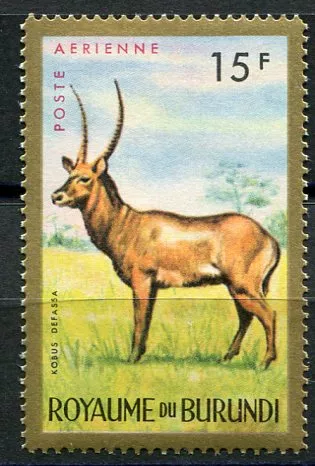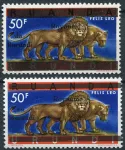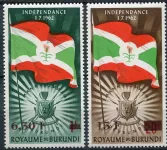- Home
- Philately: postage stamps
- Philately: stamps all over the world
- Africa
- Burundi
- (1964) MiNr. 106 A ** - Burundi - Aeronautical Stamp - Defassa Waterbuck
(1964) MiNr. 106 A ** - Burundi - Aeronautical Stamp - Defassa Waterbuck (Kobus defassa)
Burundi - postage stamps.

| Code: | BUR-106A |
| Producer: | Burundi |
| Price: | 1,43 EUR |
| Availability: | Sold out - do not order! |
| Stock: | 0 Pcs |
| Denomination of the stamp: | 15 F |
| Year: | 1964 |
| Condition: | ** |
| Catalogue no. (MICHEL): | 106 A |
| Cat. number (St. Gibbons): | 96 |
| Cat. number (Yvert et Tellier): | PA 5 |
Defassa Waterbuck (Kobus defassa): the stealthy giant of the African savannah
Defassa Waterbuck (Latin Kobus defassa) is a large ungulate of the turidae family (Bovidae) that inhabits large areas of sub-Saharan Africa. It is one of the so-called waterbuck antelopes, i.e. antelopes that prefer moist habitats near rivers, lakes or wetlands. Unlike its relative the white-toothed waterbuck (Kobus ellipsiprymnus), with which it was long considered a single species, the Defassa Waterbuck has a more distinctive brown coat and a light patch on the back of its body that does not merge into a circular pattern.
Taxonomy and distribution
-
Defassa waterbuck is now a separately recognized species, although in the past it was considered a subspecies of the white-toothed waterbuck.
-
Scientific classification:
-
Order:Artiodactyla (Sudooptera)
-
Family: Bovidae
-
Family: Kobus
-
-
Their range covers central, west and eastern Africa - from Senegal to Chad to Ethiopia and northern Tanzania. In East Africa, it is gradually being replaced with the related species Kobus ellipsiprymnus.
Morphology and distinguishing characters
-
The males reach a weight of up to 270 kg and a height at the withers of about 130 cm. Females are smaller and lighter.
-
The typical characteristic is a thick, coarse coat with water-repellent properties. The coat colour is brown to reddish brown with white markings around the eyes, on the muzzle and on the back of the body.
-
The males have robust, spirally curled horns up to 100 cm long.
Breeding and Ecology
The Waterbuck dephassa is a diurnal animal that stays in small herds consisting of several females and young. Males tend to be territorial and mark their territory with scent gland excretions.
-
Their occurrence is strongly linked to the availability of water. Even during the dry season, they stick close to water sources.
-
They are mostly grazers - feeding on grasses, and occasionally on leaves and shoots of shrubs.
-
Although they can swim well, they only enter the water when threatened. The aquatic environment provides them with protection from predators, especially lions and hyenas.
Reproduction
-
Females usually give birth to one calf after a gestation period of approximately 8 months.
-
The young initially hide in dense vegetation and the mother visits them several times a day to nurse.
-
They reach sexual maturity at 2-3 years of age.
Protection and Endangerment
According to the International Union for Conservation of Nature (IUCN), the Defassa Waterbuck is listed as Near Threatened. The main threats are:
-
Loss of natural environment due to expansion of agriculture and human settlements,
-
hunting for meat and trophies,
-
disturbance to aquatic habitats.
Despite relatively wide distribution, populations are fragmenting, increasing the risk of local extinction. Protection of the species relies on a network of protected areas and national parks, particularly in countries such as Uganda, Burkina Faso and Kenya.
Frequently Bought Together - (1964) MiNr. 106 A ** - Burundi - Aeronautical Stamp - Defassa Waterbuck (Kobus defassa)
From the Same Category - (1964) MiNr. 106 A ** - Burundi - Aeronautical Stamp - Defassa Waterbuck (Kobus defassa)
Burundi - postage stamps. The Zebra and the Antelope: Encountering the Contrasts of the African Savannah The African savannah is home to many fascinating creatures, but few can capture your attention for their differences like the antelope and zebra ...
Burundi - postage stamps.
Northern Rhodesia - postage stamps A note from the series.





